Counter-attacking plays
Use this session to improve your players’ ability to sustain position, deal with pressure, and produce confident counter-attacking play

| Area | Full pitch |
| Equipment | Balls, goals |
| No. of Players | 22 |
| Session Time | |
This session looks at improving players’ ability to sustain position, deal with pressure, and produce confident counter-attacking play.
Particularly away from home, the ability to counter-attack with pace and quality offers teams the option of sticking or twisting. I find that, if done properly, counter-attacking shouldn’t be something that compromises team shape, because players are advancing into empty space.
The session should last approximately one hour.
What do I get the players to do?
In any counter-attacking move, the key player is the one who acts as the pivot. This player controls the breakaway pass, is composed in surveying forward options, and releases to a supporting team mate when the time is right.
In our warm-up, this man is either of the two attacking players in a 4-4-1-1 formation. To begin, we have two banks of four players – a back four defending deep on the edge of the box with another four players further ahead but in the defensive half. One holding striker hovers near the arc of the centre circle with an out-and-out striker on the halfway line.
We rehearse two variations – either playing out from the back to the holding striker, who pivots and progresses forward looking for support from the full-backs (1a); or hitting the top striker whose job it is to hold the ball, wait for support, and lay off a pass (1b).
1a
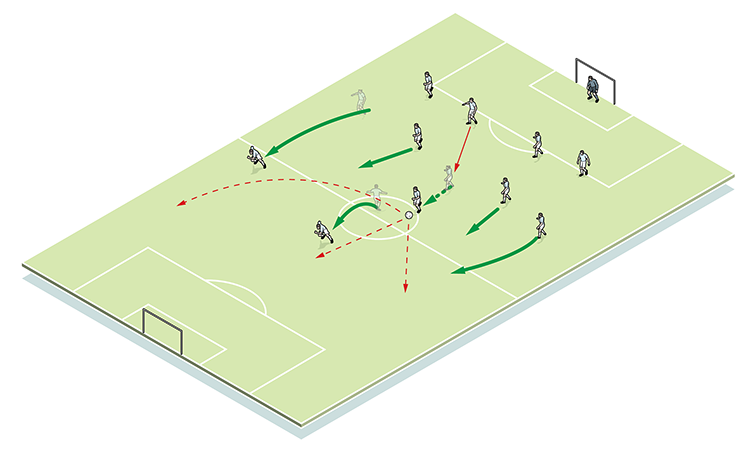
1b
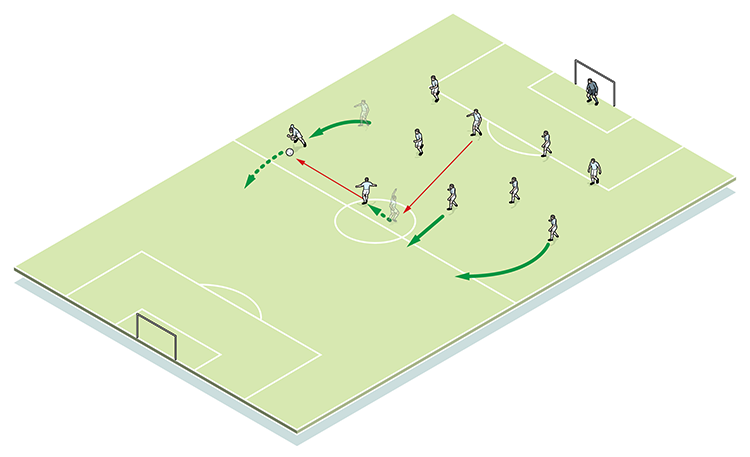
How do I put this into a game situation?
The game provides the main part of this session, and requires 11v11 (including keepers) on a full pitch. We create a 30x30 yard box around the centre circle, in which there is a 5v5. At each end of the pitch there is a 3v2 defensive overload (2a).
Play starts in the central box with either team looking to string together three consecutive passes. If successful, the ball is played to one of the two strikers. Three team mates from the central box can now break in support of the move. One defender can also come out, attempting to slow the attack (2b).
The attacking team has eight seconds to score (2c). If they fail to, either because they time passes, or the defensive team wins back possession (2d), play restarts with the other team in the central box.
2a
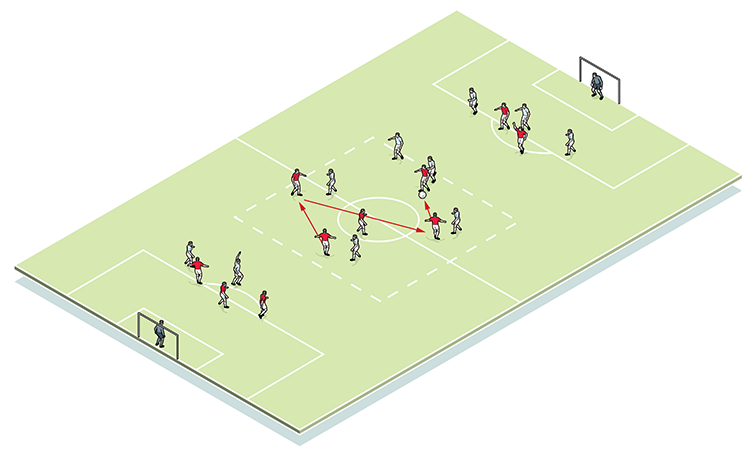
2b
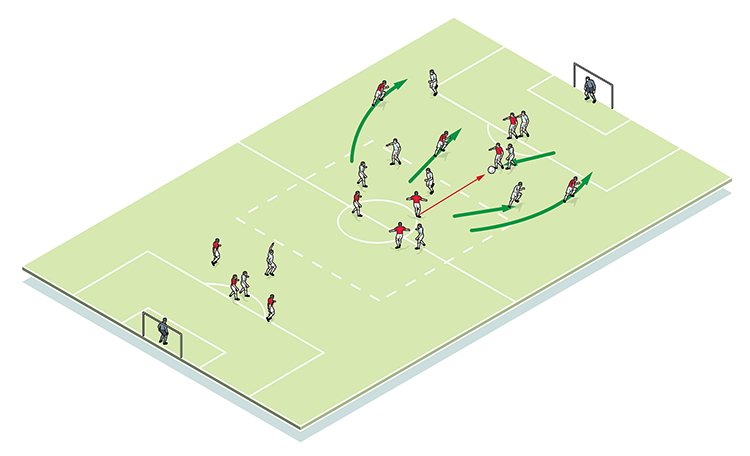
2c
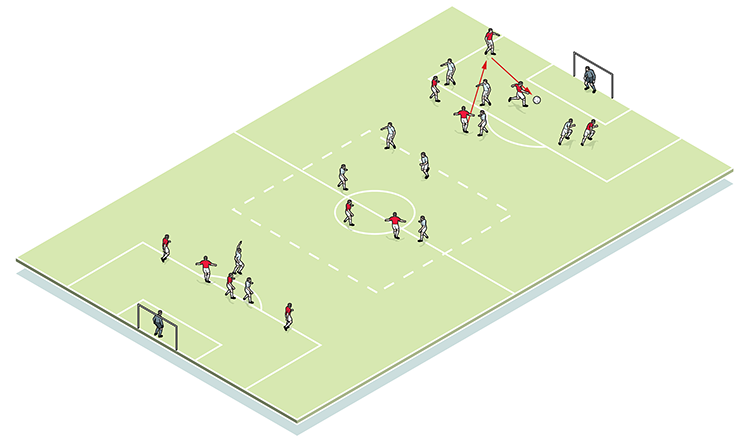
2d
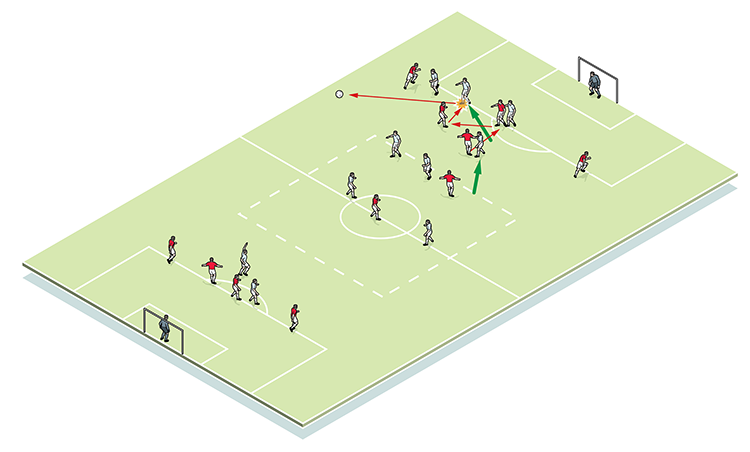
What are the key things to look for technically/tactically?
We look for good ball retention from the first pass into either striker. When breaking, pace and precision is a necessity. We need to ensure the attack is direct and it’s important to support with both wings. So two of the three breaking players should go to the flanks and the other will hold in support of the two strikers in the box.
Defenders must be solid in their positions .
Editor's Picks
Attacking transitions
Deep runs in the final third
Using the goalkeeper in build-up play
Intensive boxes drill with goals
Penetrating the final third
Creating and finishing
My philosophy
Pressing initiation
Compact team movement
Coaches' Testimonials

Alan Pardew

Arsène Wenger

Brendan Rodgers

Carlos Carvalhal

José Mourinho

Jürgen Klopp

Pep Guardiola

Roy Hodgson

Sir Alex Ferguson

Steven Gerrard
Coaches' Testimonials

Gerald Kearney, Downtown Las Vegas Soccer Club

Paul Butler, Florida, USA

Rick Shields, Springboro, USA

Tony Green, Pierrefonds Titans, Quebec, Canada
Join the world's leading coaches and managers and discover for yourself one of the best kept secrets in coaching. No other training tool on the planet is written or read by the calibre of names you’ll find in Elite Soccer.
In a recent survey 92% of subscribers said Elite Soccer makes them more confident, 89% said it makes them a more effective coach and 91% said it makes them more inspired.
Get Monthly Inspiration
All the latest techniques and approaches
Since 2010 Elite Soccer has given subscribers exclusive insight into the training ground practices of the world’s best coaches. Published in partnership with the League Managers Association we have unparalleled access to the leading lights in the English leagues, as well as a host of international managers.
Elite Soccer exclusively features sessions written by the coaches themselves. There are no observed sessions and no sessions “in the style of”, just first-hand advice delivered direct to you from the coach.









